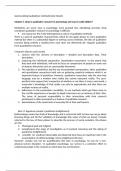Samenvatting kwalitatieve methode boek Howitt.
Chapter 1 what is qualitative research in psychology and was it really hidden?
Definitions are never easy in psychology. Even granted this, identifying precisely what
constitutes qualitative research in psychology is difficult.
one reason for this is the heterogeneous nature of qualitative methods.
There is a pool of qualitative characteristics which do not apply always to every qualitative
method but there is a substantial degree of overlap across methods. the idea of qualitative
research being entirely a statistics-free zone does not effectively dis- tinguish qualitative
from quantitative research.
5 features (Denzin and Lincoln)
1. concern with the richness of description = detailed and descriptive data. Thick
description.
2. Capturing the individuals perspective. Quantitative researchers, to the extent that
they deal with individuals, will tend to focus on comparisons of people on some sort
of abstract dimension such as a personality dimension.
3. The rejection of positivism and the use of postmodern perspectives. Note: qualitative
and quantitative researchers both rely on gathering empirical evidence which is an
important feature of positivism. However, qualitative researchers take the view that
language may be a window onto reality but cannot represent reality. The post-
positivist view argues that, irrespective of whether or not there is truly a real world, a
researcher’s knowledge of that reality can only be approximate and that there are
multiple versions of reality.
4. Adherence to the postmodern sensibility: to use methods which get them close to
the real-life experiences of people (in-depth interviews are an instance of this). Also,
The sense of personal responsibility in their interactions with their research
participants is often promoted as a feature of qualitative research.
5. Examinations of the constraints of everyday life of their participants.
Box 1.1 Agustuse compte’s positivism (enlightment)
Epistemology means the study of knowledge and is concerned with (a) how we can go about
knowing things and (b) the validation of knowledge (the value of what we know). Compte
referred to the law of three phases to describe the process of social evolution. the phases
are the
1. Theological (god and religion)
2. metaphysical (the stage of investigation as it involved reasoning and the asking of
questions) (enlightment)
3. scientific (or ‘positive) (observable and observed facts have an important role in the
accumulation of valid knowledge. (since enlightment till now)
However, compte was not for quantification like later in psychology, he was for a non-
physical science discipline. ‘In qualitative psychology, our science is a collective effort to
understand people in the contexts in which they live and function’.
,In general:
Quantitative data are regarded as hard and reliable whereas qualitative data are
regarded as rich and deep. Traditionally, mainstream psychologists often spoke of
hard data as opposed to the more subjective soft data.
Research strategies in quantitative research tend to be highly structured whereas
those of qualitative research are relatively unstructured.
The social relationship between the researcher and participant is distant in quanti-
tative research but close in qualitative research.
Quantitative researchers tend to see themselves as outsiders whereas qualitative
researchers tend to see themselves as insiders. That is, there is relatively little ‘dis-
tance’ between researcher and participant in qualitative research.
Quantitative research tends to be about the confirmation of theoretical notions and
concepts (as in hypothesis testing) whereas qualitative research is about emerging
theory and concepts.
Research findings in quantitative research tend to be nomothetic whereas they tend
to be idiographic in qualitative research. Nomothetic refers to studying groups or
classes of individuals, which leads to generalised explanations, whereas idiographic
refers to the study of an individual as an individual.
In quantitative research, social reality is seen as static and external to the individual
whereas in qualitative research social reality is constructed by the individual.
The major characteristics of qualitative data:
A common accusation is that psychology actually employs an idiosyncratic (if not
peculiar) ‘received view’ of the nature of science:
Objects in the natural world are regarded as objective and real, and they enjoy an
existence independent of human beings. Human agency is basically incidental to the
objective character of the world ‘out there’.
It follows from this that scientific knowledge is determined by the actual character of
the physical world.
Science comprises a unitary set of methods and procedures, concerning which there
is, by and large, a consensus.
, Science is an activity that is individualistic and mentalistic. The latter is sometimes
expressed as ‘cognitive’.
The alternative argument is that science is socially constructed by human beings:
who can never directly observe the ‘real’ world;
who impose a view of the nature of the world through science;
who show relatively little consensus as to the appropriate methods and procedures;
and
who act collectively and socially as part of the enterprise of science.
The use of mixed methods (e.g. qualitative and quantitative in the same study) is regarded
by some as having substantial benefits. For example, they might use both questionnaires and
in-depth interviews in a study. It is less likely, though, that researchers flit between
experimental methodology and discourse analysis or conversation analysis. To clarify,
qualitative approaches in psychology include a substantial range of different research
activities with very different epistemological foundations. Importantly, this list includes both
qualitative data collection methods (e.g. focus groups) and qualitative data analysis methods
(e.g. grounded theory). (let op: heht is mogelijk om qualitatieve data op een kwantitatieve
manier te analyseren!).
New in qualitative research psychology: the formulisation of qualitative analysis
procedures.
Kuhn: A paradigm is a sort of worldview – a comprehensive way of looking at things which is
more extensive than, say, a theory is. So a paradigm shift is a fundamental change in the
ways in which scientists view their subject matter. As scientists become aware of anomalies
thrown up by the current paradigm then this eventually leads to a crisis in the discipline. A
paradigm shift requires a radical change in the way we go about understanding the world.
Simply choosing to study a different aspect of the world does not imply a paradigm shift.
Since both approaches (qualitative and quantitative methods) may viably coexist, then one
cannot speak of a paradigm shift in this case.
, The logical positivists, behaviourism and psychology
The defining features of logical positivism were its dependency on empiricism together with
the use of logical deductions from mathematical and other concepts.
Operationism is the idea that concepts in science (including psychology) are defined by the
processes used to measure them.
Watson’s behaviourism, saw psychology as (a) part of natural science and (b) an
objective experimental approach to the prediction and control of behaviour – following
Comte’s view that the purpose of science lay in prediction. > a search for the laws of human
behaviour. Thus knowledge came from one’s direct observations based on experience and
from the application of tight logical reasoning
In sum, the characteristics of science according to the logical positivist/behaviorist:
Science is a cumulative process.
Sciences are reducible ultimately to a single science of the real world.
Science is independent of the characteristics of the investigator.
For Watson, psychology was a natural science which would eventually be reducible to a
science like physics and chemistry. Logical positivism, it should be noted, gave to psychology
through its influence on behaviourism the principle of verification. This means that ideas
(maybe theories or hypotheses) are only meaningful to the extent that empirical research
allows them to be tested to see whether they remain viable or whether they should be
rejected.
Box 1.2 social constructionism
• Knowledge sustained by social processes Social con- structionists argue that knowledge is
constructed by people through their interactions. our version of knowledge is therefore
substantially the product of language in the form of conversation, etc. in our everyday lives.
• Historical and cultural specificity of language the way that we think about any aspect of
the world will vary in different cultures and in the same culture at different time periods.
• Critical position on ‘taken-for-granted’ knowledge: the ways in which people perceive the
world do not correspond to a reality. (while mainstream psychology: the researcher can
observe the world objectively.
•Knowledge and social action are integrated the differ- ent constructions that we have about
the world each have their implications for different sorts of social action.





